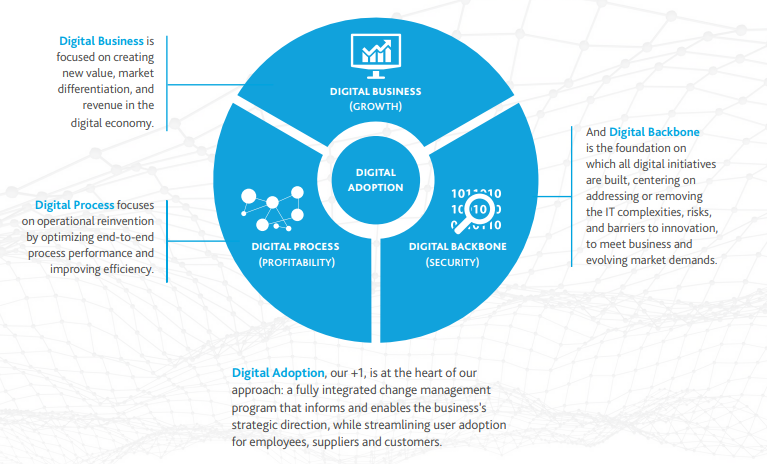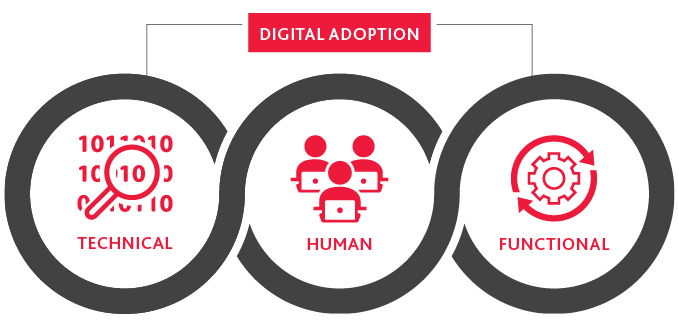Building a Digital Transformation Strategy Part 4
Part 4: Accelerating Adoption
It’s a modern catch-22: To survive disruption, middle market organizations must embark on digital transformation now—and yet, according to a large body of research from the change management industry, most change initiatives fail. The rate of failure is consistently estimated at 70%, based on a now decades-old study from leadership expert John Kotter. Recent surveys from McKinsey and Bain suggest the rate of failure for digital transformation, specifically, is even higher than that of conventional business transformations. If you’re damned if you do and damned if you don’t, why bother with digital transformation in the first place?
The reality, of course, is not so black-and-white. If success is defined as nothing less than achieving 100% of expected results, then by that standard, most digital transformation initiatives fail. If our metric for success is any degree of performance improvement, the data tells a different story. The issue is not that digital transformation is a total failure, but that it frequently falls short of its full potential.
The takeaway from this should not be to dismiss digital transformation as a waste of effort. Disruption goes on with or without our willing participation. Significant value can be captured if we get to the root of problem—one that comes down not to technology, but to people. Digital transformation initiatives fall short for four primary reasons: 1) change fatigue, the result of an increasingly frenetic pace of change and disillusionment from prior change initiatives that never came to bear; 2) unfocused or poorly articulated strategic direction; 3) lack of buy-in across the change ecosystem; and 4) a gap in skills.
Change is hard—whether it’s digital or not—and too often, facilitating that change is treated as an afterthought. That’s where an intentional approach to digital adoption and business enablement comes in. For digital transformation to succeed, organizations must focus as much on the why and the how as they do on the what.
Digital 3+1
While every company must follow its own trajectory, we can generally break down digital transformation into three primary strategic drivers, as outlined in BDO’s Digital 3+1 approach:

While Digital Adoption may seem, at first glance, to be synonymous with change management, it’s not. Traditional change management is limited in its purview to the internal organization. The intent of digital transformation, however, is to have transformative impact across the entire business ecosystem. Vendor and customer acceptance of change is as critical to success as employee adoption—especially if it requires them to change their behaviors or if there is even the slightest of learning curves.
To understand the role digital adoption plays in your digital transformation, ask yourself these questions:
-
Does my organization understand and believe in the strategic vision?
-
Are all key business stakeholders on board and actively engaged in enabling transformation?
-
Do our frontline employees understand their role in making transformation successful?
-
Do I have the right talent and skillsets to support new digital capabilities and processes?
-
Have I put in place reinforcement mechanisms to foment lasting cultural change?
-
Do I have the necessary tools to facilitate customer understanding?
Essential to any digital initiative's successful implementation, digital adoption can be broken down into three key elements:

The Human Element
Winning hearts and minds
In the face of digital disruption, people are more essential, not less. To fully realize the value of their digital investments, organizations must give equal weight to enabling the people behind the technology. Just like buying the world’s best paintbrush doesn’t suddenly make you an artist, access to the latest innovations won’t deliver improvements if no one uses them—whether because they don’t know how, they don’t want to use them or they aren’t even aware they exist. Digital transformation thus hinges entirely on convincing, engaging and empowering people.
This human element is sometimes conflated with the functional and technical elements of rolling out a plan for change. Such an approach overestimates the power of processes and underestimates the strength of cultural resistance to change. Lasting business enablement requires behavior change at every level of the organization—and beyond. Behavior change can’t be forced, but it can be inspired and influenced—not by change management, but by change leadership.
The difference is the level of proactivity. Traditional change management assumes that humans are rational decision-makers and will willingly embrace change if it is logically presented. The majority of time and investment is spent upfront on check-the-box processes and rote communication—as if change will magically unfold of its own volition.
Change leadership, on the other hand, assumes a certain level of resistance, methodically gets to the root causes of that resistance and stages interventions to drive the desired behaviors.
Change leadership harnesses the psychology behind behavior change to build a shared sense of purpose. Dictating the way forward is not nearly as persuasive as communicating a vision to people who feel they had a role in shaping it. Key stakeholders should be actively courted and invited to participate at the onset of a new initiative, rather than waiting to bring them in until after all the decisions have already been made. Every layer of the business should have a voice in creating the digital agenda—not only to build consensus and conviction, but to ensure the inclusion of diverse experiences and intellectual capital.
Once you have initial stakeholder buy-in, regular engagement and incentivization is key. However, the ability to convince and engage the masses starts and stops with the senior-most levels of the firm. You must have executive sponsorship for digital transformation to get off the ground. Not only do you need their buy-in, but you need them to be early adopters of new technology to serve as role models for the organization at large.
The Functional Element
Planning & execution
The functional element of digital adoption focuses on operationalizing change. According to BDO’s 2019 Middle Market Digital Transformation Survey, just over half of executives have a documented change management plan in place to drive digital adoption. While digital initiatives are fluid by nature, developing an implementation roadmap focused on the people side of transformation goes a long way to ease the transition. This entails mapping out who will be impacted—both inside the organization and outside it—how they will be impacted and reimagining how they perform their job. The next step is to assess whether they have the right skills to perform their roles, and if not, whether those skills can be learned or if you’ll need to bring in new talent. In some cases, the scope of digital transformation may necessitate a redesign of organizational structure, so that people and processes are better aligned with strategic priorities. Ideally, this exercise is done before you roll out a new digital initiative to minimize confusion.
The Technical Element
Enabling the business
The technical element of digital adoption is comprised of the toolsets and mechanisms to not just enable but sustain change. And, just as technology has disrupted the rest of the world, many of these tools have gone digital, or at the very least, adapted to meet the demands of the digital environment, accelerating the speed of change adoption. Digitizing these tools also makes tracking digital adoption KPIs much easier.
Talent development is one such technical element that has become more effective and easier to implement with a combination of new technologies and science-backed techniques. BDO’s 2019 Digital Transformation Survey found that 62% of executives are implementing training to upskill employees. Best-in-class training and development programs are no longer once-a-year, in-person affairs, but executed via on-demand e-learning platforms and interactive tutorials leveraging augmented reality as continuous learning becomes the new standard. They are designed to accommodate different learning styles and preferences, offering personalized experiences in a scalable way.
When building a digital reskilling program, a key challenge is accurately gauging current capabilities without the bias of self-assessment. Now, organizations can take advantage of HR analytics and easy-to-administer digital diagnostics to systematically analyze skills gaps and evolve training accordingly.
Programmatic reinforcement is another critical lever for sustained digital adoption and business enablement. Here, the psychology behind behavior change and our evolving understanding of neuroscience becomes key. Research shows that positive reinforcement is usually more successful in motivating new behaviors than punitive measures. Monetary incentives tend to be the fallback, but compensation isn’t always the greatest motivator, and has diminishing returns after repetition. A growing number of organizations are gamifying adoption of new technology, which can promote healthy competition, elicit a positive emotional response and improve memory retention.
While reinforcement is most often thought of in terms of carrot and stick, there is another means of reinforcement: making the new behavior more desirable than the old one. The user experience of new technology can make or break adoption. Applying design thinking principles to the rollout of new digital capabilities or functionalities can help alleviate resistance to change. The more intuitive the user interface, the easier it is to get new users on board. Taking the principles of design thinking a step further, rolling out new digital capabilities in an iterative fashion tends to resonate better with the end user than sweeping change all at once.
Creating a formal feedback mechanism is another essential enabler of digital adoption. Instituting a feedback loop is vital to assessing that acceptance and adoption of new technology is on the right track.
Accelerating Adoption
Digital transformation can feel like a leap of faith—a bet against the odds that your company’s investment will pay off in full. And yet, the alternative is unpalatable: a slow, painful decline into irrelevance.
But digital transformation isn’t a game of chance; the difference between those who succeed and those who fail comes down to preparation and execution. A more apt comparison is to a team sport, where winning is a function not only of athletic talent and smart strategy, but also of good coaching and team cohesion. The people, not the equipment, make the game.
For digital transformation to deliver, you need to build your own dream team—and you need to build it well before the starting buzzer. Like any good coach, you need to inspire your team, motivate them to improve and fill the holes in your roster. It’s hard work, sometimes painful, but always necessary to reach your goals. You can’t luck into digital adoption, but with the right approach, you can accelerate it.
Find out how we help organizations strategically develop the readiness and capacity to change with BDO’s Digital Transformation Accelerator.
Accelerate Your Digital Transformation
Would you like to learn more about BDO’s Digital Transformation Services? Learn more here.


SHARE